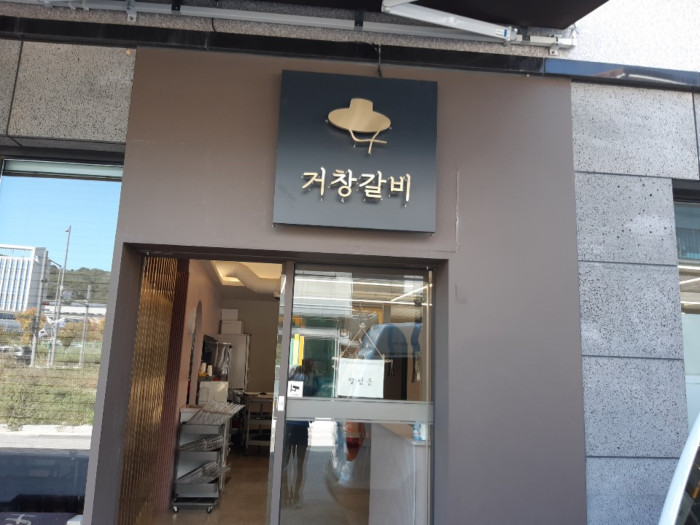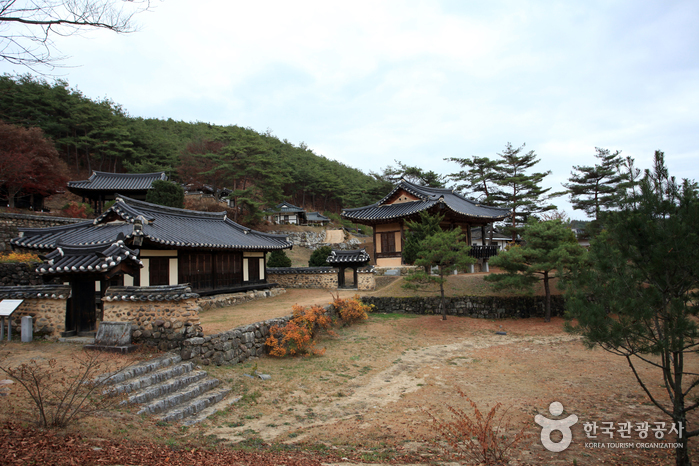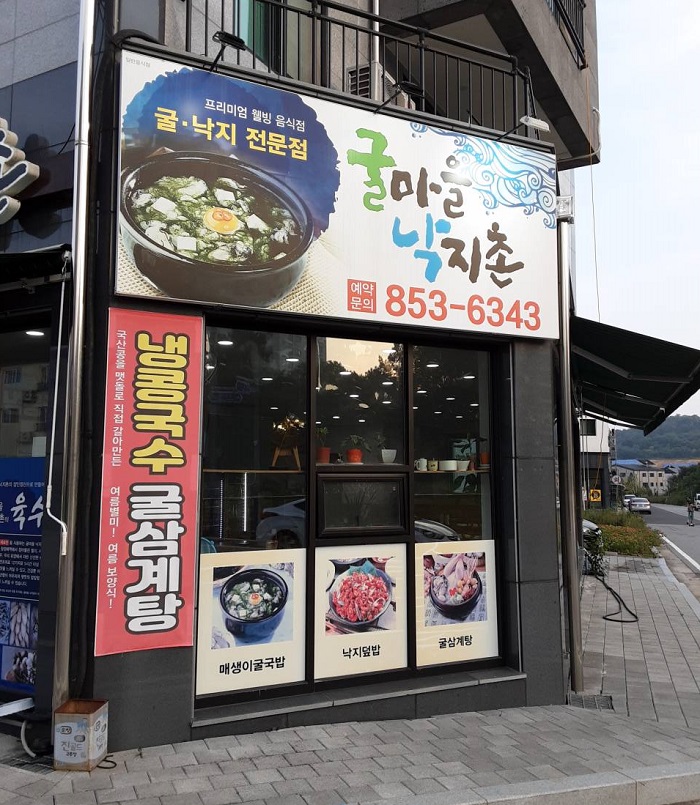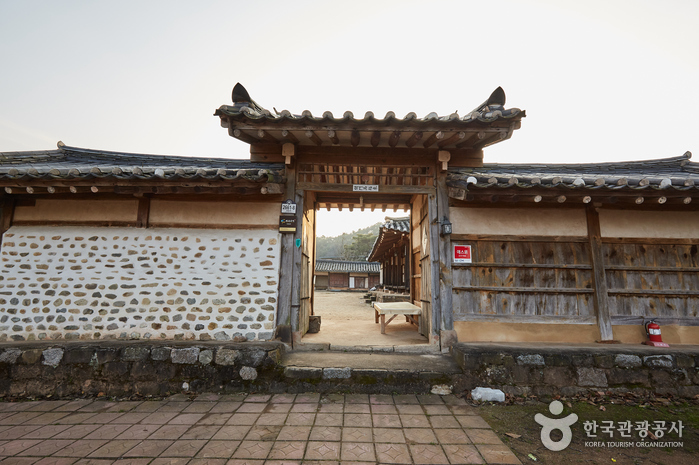Geochang Galbi - Docheong Branch (거창갈비 도청)
17.7Km 2021-03-26
48-14, Pungyo 3-gil, Andong-si, Gyeongsangbuk-do
+82-54-843-0099
It is a place where you can enjoy Korean BBQ. This restaurant's signature menu is grilled Korean beef ribs. This Korean dishes restaurant is located in Andong-si, Gyeongsangbuk-do.
Village Gunja à Andong (Site des reliques Ocheon) (안동 군자마을(오천유적지))
17.7Km 2021-03-16
29, Gunjari-gil, Waryong-myeon, Andong-si, Gyeongsangbuk-do
+82-54-852-5414
Le site historique Ocheon est un village reconstitué lors de la construction du barrage Andong en 1974. Le village originel fut fondé par Kim Hyo-Ro, ancêtre de la branche Yean de la famille Kim de Gwangsan, et habité pendant 600 ans par ses descendants.
Dans ce site se trouvent des biens culturels nationaux tels que Takcheongjeong et Hujodang (voir plus bas).
Le site inclut le musée Sungwongak où sont exposés de précieux documents rédigés par les membres connus de cette famille ainsi que les actes d'état civil et divers titres de possessions de terres et d'esclaves. Parmi eux ont été déclarées "trésor" par l’Etat coréen 7 catégories de documents anciens répartis dans 429 pièces différentes et 13 catégories de livres des records englobant 61 volumes.
Takcheongjeong
C’est un pavillon annexé à la maison principale de la branche Yean de la famille Kim de Gwangsan. La maison a été construite en 1541. Pour un bâtiment de ce genre, il est plutôt majestueux et imposant, ce qui le fait considérer comme un important bien culturel. La plaque portant le nom du bâtiment a été placée sous le toit et au-dessus de la porte de l’immeuble. Elle a été écrite par Han Ho, un des trois grands calligraphes de la dynastie Joseon.
Hujodang
C’est une résidence secondaire appelée Byeoldang. Elle est annexée à la maison principale de la branche Yean de la famille Kim de Gwangsan. L’année de sa construction est ignorée, mais on sait qu'elle a été élevée par Kim Bu-Pil (1516~1577).
Immeuble séparé de la maison principale, un Byeoldang se divise en deux zones : Byeoldang extérieur et Byeoldang intérieur.
La première était utilisée pour le repos et la méditation des hommes de la maison, alors que la seconde était destinée aux grand-mères ou aux filles approchant l’âge de se marier.
Hujodang est un Byeoldang extérieur.
Gulmaeul Nakjichon (굴마을낙지촌)
17.8Km 2021-03-24
26, Pungyo, 3-gil, Andong-si, Gyeongsangbuk-do
+82-54-853-6343
It is a place where you can eat various seafood dishes and soup. The best menu at this restaurant is oyster and rice soup. This Korean dishes restaurant is located in Andong-si, Gyeongsangbuk-do.
Jeongjae Head House / 정재종택
20.0Km 2025-08-12
경상북도 안동시 임동면 경동로 2661-8
+82-10-8590-0625
Boasting more than 300 years of tradition, Jeongjae Traditional House is the head house of Ryu Chi-myeong (pen-name: Jeongjae), who inherited the study of Togye Yi Hwang (1501-1570), one of the two most prominent Korean Confucian scholars of Joseon. The old house features the characteristic construction elements of a Joseon hanok, including the stylobate, wooden pillars, toenmaru (the narrow wooden porch running along the outside of the building), tiled roof, and other structures, and commands an open view of Imha Lake. The house was originally built by Ryu Gwan-hyeon, the great-great-grandfather of Ryu Chi-myeong, in 1735 (the 11th year of the reign of King Yeongjo of Joseon) in the village of Handeul in Imdong-myeon, Andong-si, Gyeongsangbuk-do, but it was relocated to the foot of Guamsan Mountain in 1987 when Imha Dam was built and the surrounding area was submerged as a result. The house consists of the daemunchae (gate building), jeongchim (a ‘ㅁ’-shaped house with a tiled roof), haengnangchae (servants’ quarters), a shrine, and a pavilion. The sarangchae (men’s quarters) is clearly visible, while the anchae (women’s quarters) is concealed within the house. The sarangchae has a sarangmaru (wooden floor), a large sarangbang room, a small sarangbang room, and there is a small maru between the two rooms. The buildings of the sarangchae and anchae are clearly divided into segregated spaces for men and women according to Confucian tradition. The anchae has a daecheongmaru (large wooden floor) in the middle; a main room, kitchen, and toilet on the right; and a numaru (upper floor) and sangbang (upper room) on the left. The small side door of the main gate links to the door by which to enter the anchae, which has a small vegetable garden. Manujeong Pavilion (Gyeongsangbuk-do Cultural Heritage Material No. 37) is a half-hipped roof building with single-layered eaves located on the left side of the house outside the main gate. It is the place where Ryu Chi-myeong used to teach his students, and consists of a large maru and a guest room. The pavilion is also surrounded by the beautiful scenery of Imha Lake, mountains, and chestnut trees. Jeongjae Traditional House provides two special experience programs: Making Songhwaju, which is the Ryu family’s home-brewed liquor (15 to 18 degrees) made with rice, glutinous rice, yeast, pine needles, and chrysanthemums, led by the owner’s wife (Intangible Cultural Asset No. 20); and Making Tarak, which is a fermented milk drink that has been made by the Ryu’s family for some 500 years. As the recipe for making Tarak is relatively simple, and uses yeast that is usually used to make raw rice wine like Makgeolli, people can easily make it at home. The house also runs a traditional music program designed to show participants how to play the gayageum (Korean zither with twelve strings) and sing Korean folk songs, and stages small concerts.




 Français
Français
 한국어
한국어 English
English 日本語
日本語 中文(简体)
中文(简体) Deutsch
Deutsch Español
Español Русский
Русский